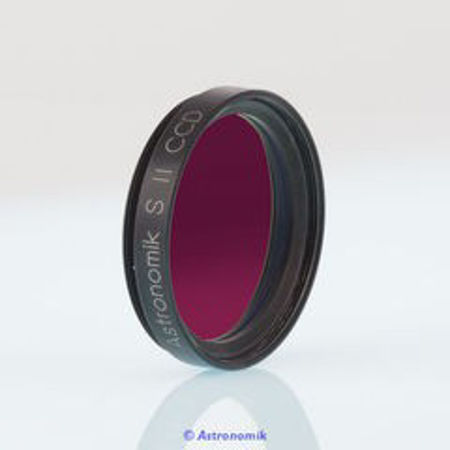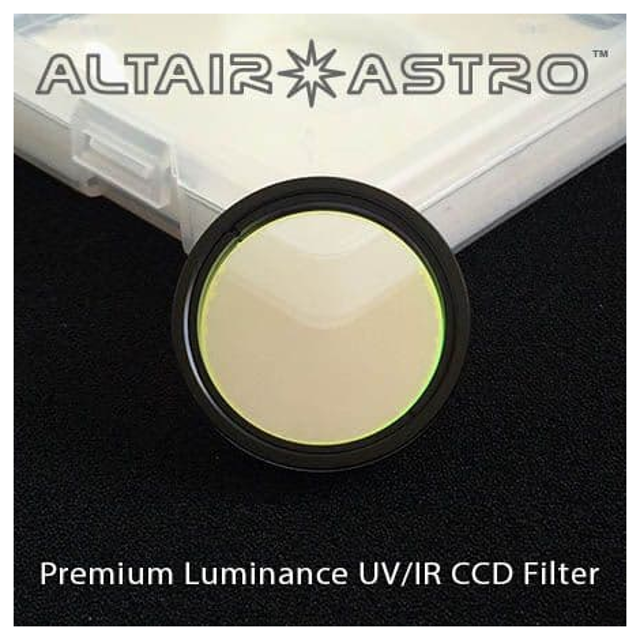CCD Filter for Astrophotography
- Home /
- Optical Accessories /
- CCD Filter for Astrophotography
Filters for Astrophotography

With modern interference filters, amateur astronomers can now achieve excellent image results. The applications include narrow-band emission line filters, broader-band color filters and filters for suppressing artificial light emission.
CCD Filter for Astrophotography
Altair DualBand 6nm Filter Features:
- Capture the two main emission nebulae bands at the same time, whilst suppressing light pollution, moonlight, and airglow.
- Acquire more data in less time, opening up your imaging window, even into the summer months when it isn't quite dark.
- If you have the 6nm Ha/Sii Ultra filter and the Sii/Ha version, you can capture twice the Oiii data in each imaging session and combine them for true SHO Hubble style imaging with a colour camera!
- Extremely steep bandpass yields maximum contrast in extreme light pollution: 6nm FHWM centred on 500.7nm Oiii wavelength, and 5.5nm FHWM centred on the 656.28nm Ha wavelength.
- Halo suppression anti-reflective coating.
- Can be used with One Shot Colour (OSC) CMOS or mono astronomical cameras for luminance data.
- Includes UVIR blocking for both modified and un-modified DSLR cameras, plus an anti-reflection coating for the ultimate in contrast.
- Best performance at focal ratios at F4.8 or slower, however can be used as fast as F3.6, with minimal contrast impact (conservative estimate - faster may be possible). Like any dichroic filter, contrast increases as focal ratio number increases. More info about light pollution filter performance and focal ratio here.
209.00 €
Estimated delivery time : 1-2 weeks
Altair DualBand 6nm Filter Features:
- Capture the two main emission nebulae bands at the same time, whilst suppressing light pollution, moonlight, and airglow.
- Acquire more data in less time, opening up your imaging window, even into the summer months when it isn't quite dark.
- If you have the 6nm Sii Oiii Ultra filter and the Ha Oiii version, you can capture twice the Oiii data in each imaging session and combine them for true SHO Hubble style imaging with a colour camera!
- Extremely steep bandpass yields maximum contrast in extreme light pollution: 6nm FHWM centred on 500.7nm Oiii wavelength, and 5.5nm FHWM centred on the 671.6nm Sii wavelength.
- Halo suppression anti-reflective coating.
- Can be used with One Shot Colour (OSC) CMOS or mono astronomical cameras for luminance data.
- Includes UVIR blocking for both modified and un-modified DSLR cameras, plus an anti-reflection coating for the ultimate in contrast.
- Best performance at focal ratios at F4.8 or slower, however can be used as fast as F3.6, with minimal contrast impact (conservative estimate - faster may be possible). Like any dichroic filter, contrast increases as focal ratio number increases. More info about light pollution filter performance and focal ratio here.
209.00 €
Estimated delivery time : 1-2 weeks
The new TriBand V2 Filter
- Anti-Halo coating on both surfaces to reduce reflection artefacts from reducers and camera lenses.
- Increased blocking of UV, IR and unwanted visual range wavelengths. UV OD7 (T0.00001%) Visual OD5 (T0.001%) and IR OD4 (T0.01%) for the ultimate in skyglow blocking. This is an order of magnitude better than foreign filters.
- Higher transmission % of desired wavelengths Ttop 93% (Average 5% higher transmission of target wavelengths than V1). In general a 5% gain on foreign filters.
- Ha at 14nm and Oiii at 34nm FWHM for with less tail-off to reduce unwanted light pollution, whilst keeping transmission high compared to the V1.
159.00 €
Estimated delivery time : 1 week
Altair DualBand 6nm Filter Features:
- Capture the two main emission nebulae bands at the same time, whilst suppressing light pollution, moonlight, and airglow.
- Acquire more data in less time, opening up your imaging window, even into the summer months when it isn't quite dark.
- If you have the 6nm Ha/Sii Ultra filter and the Sii/Ha version, you can capture twice the Oiii data in each imaging session and combine them for true SHO Hubble style imaging with a colour camera!
- Extremely steep bandpass yields maximum contrast in extreme light pollution: 6nm FHWM centred on 500.7nm Oiii wavelength, and 5.5nm FHWM centred on the 656.28nm Ha wavelength.
- Halo suppression anti-reflective coating.
- Can be used with One Shot Colour (OSC) CMOS or mono astronomical cameras for luminance data.
- Includes UVIR blocking for both modified and un-modified DSLR cameras, plus an anti-reflection coating for the ultimate in contrast.
- Best performance at focal ratios at F4.8 or slower, however can be used as fast as F3.6, with minimal contrast impact (conservative estimate - faster may be possible). Like any dichroic filter, contrast increases as focal ratio number increases. More info about light pollution filter performance and focal ratio here.
309.00 €
Estimated delivery time : 1-2 weeks
High quality filter for CMOS photography with the following features:
- 1st band, CWL495nm FWHM35nm
- 2nd band, CWL 660nm FWHM 35nm
- 1mm thick optical glass with 30 arc sec parallelism.
- UVIR Block and Anti-Reflection Coating.
159.00 €
Estimated delivery time : 2-4 weeks
Altair DualBand 6nm Filter Features:
- Capture the two main emission nebulae bands at the same time, whilst suppressing light pollution, moonlight, and airglow.
- Acquire more data in less time, opening up your imaging window, even into the summer months when it isn't quite dark.
- If you have the 6nm Sii Oiii Ultra filter and the Ha Oiii version, you can capture twice the Oiii data in each imaging session and combine them for true SHO Hubble style imaging with a colour camera!
- Extremely steep bandpass yields maximum contrast in extreme light pollution: 6nm FHWM centred on 500.7nm Oiii wavelength, and 5.5nm FHWM centred on the 671.6nm Sii wavelength.
- Halo suppression anti-reflective coating.
- Can be used with One Shot Colour (OSC) CMOS or mono astronomical cameras for luminance data.
- Includes UVIR blocking for both modified and un-modified DSLR cameras, plus an anti-reflection coating for the ultimate in contrast.
- Best performance at focal ratios at F4.8 or slower, however can be used as fast as F3.6, with minimal contrast impact (conservative estimate - faster may be possible). Like any dichroic filter, contrast increases as focal ratio number increases. More info about light pollution filter performance and focal ratio here.
309.00 €
Estimated delivery time : 1-2 weeks
The new TriBand V2 Filter
- Anti-Halo coating on both surfaces to reduce reflection artefacts from reducers and camera lenses.
- Increased blocking of UV, IR and unwanted visual range wavelengths. UV OD7 (T0.00001%) Visual OD5 (T0.001%) and IR OD4 (T0.01%) for the ultimate in skyglow blocking. This is an order of magnitude better than foreign filters.
- Higher transmission % of desired wavelengths Ttop 93% (Average 5% higher transmission of target wavelengths than V1). In general a 5% gain on foreign filters.
- Ha at 14nm and Oiii at 34nm FWHM for with less tail-off to reduce unwanted light pollution, whilst keeping transmission high compared to the V1.
159.00 €
Estimated delivery time : 1 week
The Altair Astro Planet-Killer 685nm Premium IR Pass Filter is designed to deliver sharper lunar and planetary images with Monochrome CCD or CMOS cameras.
69.00 €
Estimated delivery time : 2-4 weeks
Premium filter features:
- Batch-tested for consistency.
- High quality dichroic/dielectric coatings.
- Anti-Reflection coating to reduce star-halos - stackable.
- UV/IR block for imaging - star bloat reduction with refractors.
- Ultra-flat glass by Schott Germany.
- Precision CNC machined filter cell for strain-free mounting and freedom from tilt.
209.00 €
Estimated delivery time : 1-2 weeks
Premium filter features:
- Batch-tested for consistency.
- High quality dichroic/dielectric coatings.
- Anti-Reflection coating to reduce star-halos - stackable.
- UV/IR block for imaging - star bloat reduction with refractors.
- Ultra-flat glass by Schott Germany.
- Precision CNC machined filter cell for strain-free mounting and freedom from tilt.
55.00 €
Estimated delivery time : 1-2 weeks
This filter transmits only the H and Oiii light from emission nebulae, with almost total suppression of unwanted light....
609.00 €
Estimated delivery time : 2-4 weeks
Altair Astro Premium 1.25" CLS-CCD Filter features:
- Multi-Layer Anti-Reflection coating to reduce star-halos and reflections from camera optical window.
- Batch-tested for consistency.
- Ultra-flat glass by Schott Germany. 1.85mm Glass 30sec parallel, optical polish to MIL Spec. MIL-O-13830.
- High quality dichroic/dielectric coatings. Electron-beam gun evaporation with Ion-assisted deposition coating technology for durability and resistance to scratching, as well as stability on CWL (central wavelength). No deviation affected by temperature change.
- UV/IR block for imaging - star bloat reduction with refractors.
- Precision CNC machined filter cell for strain-free mounting and freedom from tilt.
79.00 €
Estimated delivery time : 2-4 weeks





















